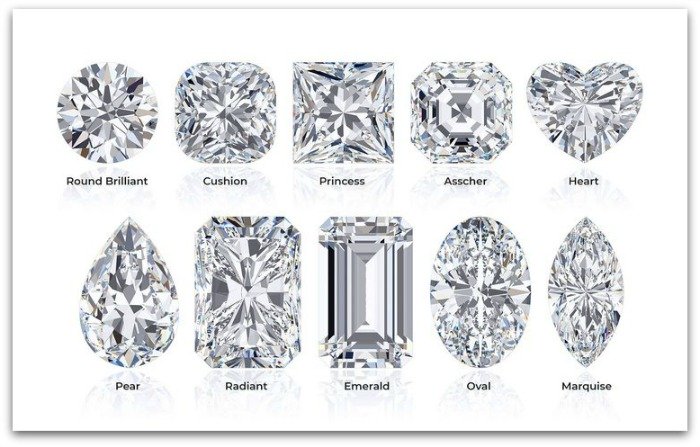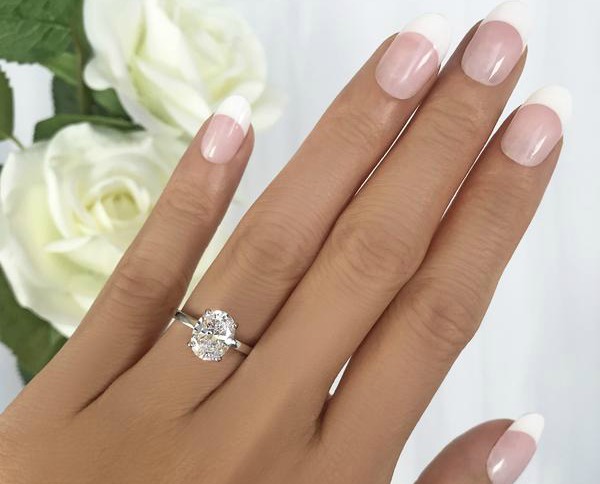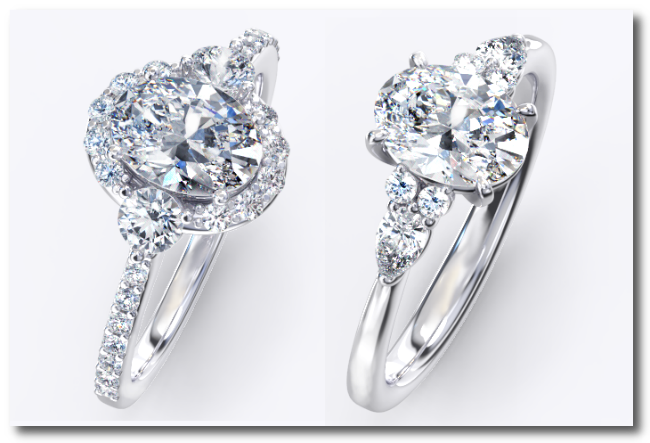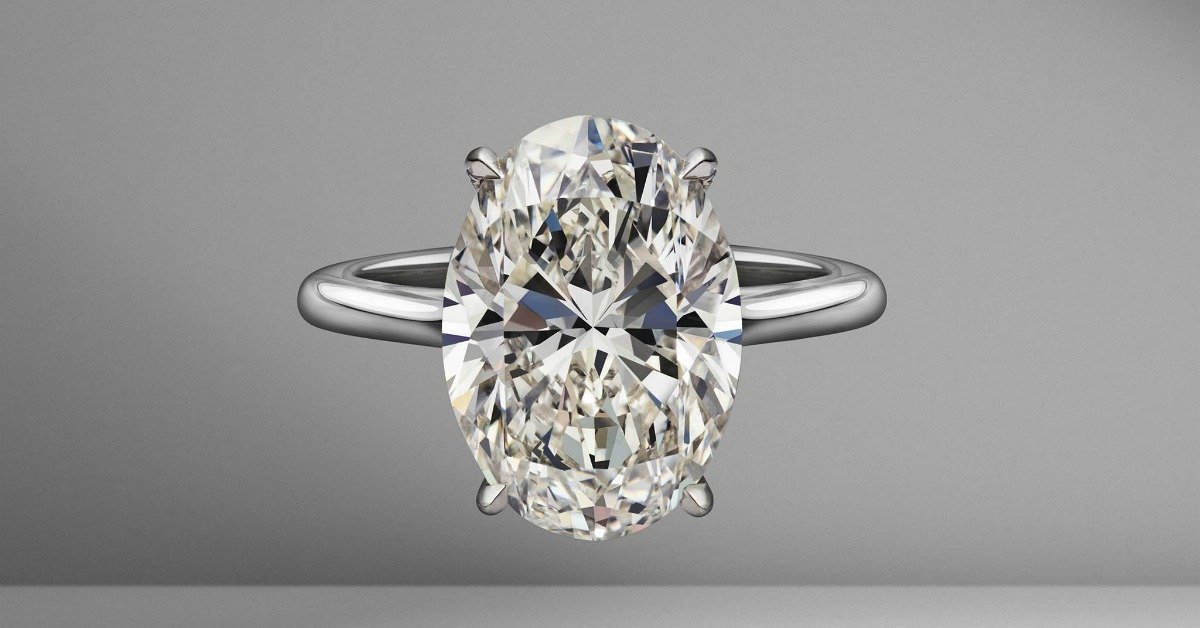
Have you seen how much oval diamonds have boomed over the past few months on social media?
It’s been quite a ride!
Designers seem to have been working in overdrive to create stunning and interesting engagement rings built around oval shaped centre stones. And they’ve done a great job.
It’s awesome to see the flood of fresh and new ideas. For a change there’s not a lot of copy and paste flying around on the internet.
Ovals are a fantastic shape choice for your engagement ring’s centre stone, and I’ll run you through all the reasons.
In the next few minutes we’ll touch on the following important facets;
- Why you want an oval diamond.
- Diamond specifications; How to get the best oval diamond for your money.
- Unique design ideas and trends.
- Some things to be weary of.
I hope this posts gives you some guidance and a good dash of #ringspiration for your own custom oval engagement ring.
Oval diamonds are sky-rocketing
There seems to be an endless variety of diamond shapes that are cranked out by factories every single day.
You get some really wild and eccentric shapes… like a horse-head. Really.
But I thoroughly recommend you stick to the top ten:
Although the round brilliant shape stays firmly in the top position, oval diamonds are creeping up behind cushions and will likely overtake them to become the second most popular diamond shape in 2019.
This is amazing if you consider the fact that ovals would historically hang at around number 5 or so on the top 10.
How this fire started
Oval shaped diamonds were the go to shape in 2018 with the vintage design craze at its height.
Although “vintage” isn’t a dominating theme anymore (for now at least) the exposure that oval diamonds received catapulted them onto many engagement ring shoppers’ radars. And with good reason… they’re beautiful in a timeless way.
Did you know perfectly round diamonds have only been around for +/- 80 years? Before the 1940s diamond cutters were unable to get a diamond perfectly round and most efforts ended up being slightly oval in shape.
So although the round shape is often seen as the “classic”, oval shapes have been around for much longer.
Getting the 4C’s perfect
Diamonds are expensive. No way around that.
Regardless of your budget, some understanding and effort can ensure you’re getting as much diamond as possible.
The price of a diamond is directly determined by it’s graded specifications/characteristics.
Higher specifications equal a higher asking price.
The diamond and jewellery industry has done a great job of condensing the main characteristics of a diamond into the straight forward 4C Model: Cut, Colour, Clarity and Carat.
Each one of these C’s has a range that indicates the quality (and corresponding price) of the specific characteristic.
To get a great looking diamond at a reasonable price these 4 characteristics need to be finely balanced. I’ll show you where the sweet spots are since certain characteristics are visually more important than others.
Carat: The (very important) size of the diamond
Nothing upgrades the look of an engagement ring more than a larger diamond.
That doesn’t have to come at the expense of compromising other specifications like the clarity, colour or quality of the craftsmanship exemplified in the diamond’s cut.
For any given weight/size the oval appears larger than any other shape. Your eye is drawn down the long axis that gives it this larger impression. Some people choose this shape solely for this reason.
To illustrate, these two diamonds weigh exactly the same…
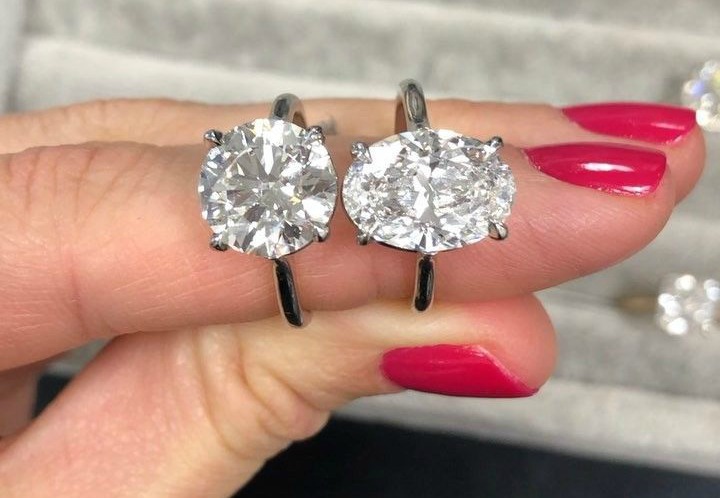
I recommend that you prioritise the size, but stick to my recommended range below for colour, clarity and cut. It’s a good roadmap.
Colour
Diamond colours range from “D” all the way down to “Z”. As you slide down the alphabet the colour of the diamond turns from colourless to yellow or brown in tiny increments. It’s very hard to tell two adjacent diamond colours apart, but the difference in price from one colour to the next is significant.
- 1,00ct D VS1 – R96 300
- 1,00ct E VS1 – R90 000
That’s a R6 000 difference for a single colour variation.
Ovals have a unique way of working with colour. Imagine taking a round stone and dragging it out into an oval shape. You get a higher concentration of facets at the outer points than in the middle of the stone. The concentrated facets at the outer edges concentrate colour slightly.
This only starts becoming obvious at “J”-colour, but I recommend you still take a look at lower colours as this phenomenon can create a very nice vintage feel. It’s only if you want the diamond to appear a shade of white that I would say draw the line at “I” colour and higher.
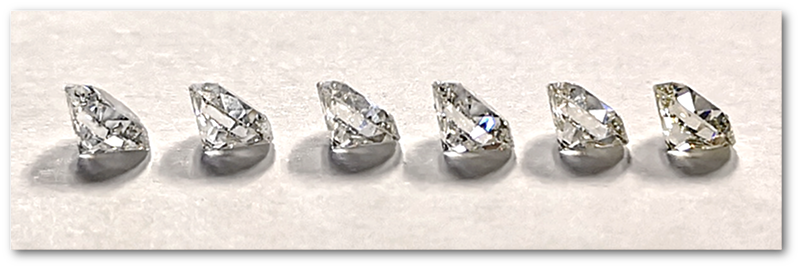
*In this image you have an F colour followed by H, I, L and then T. Do you see how slow and faint the progression is?
D-E colours are your high-end bracket. This is the crispest white you’ll find in the world of diamonds. Just know that unless you have very experienced eyes, and special white lighting, you’ll have a hard time distinguishing them from F and G colours.
F-G: The premium category, and usually my highest recommended colour range. In normal light they’re still piercingly white, but don’t carry the high premium of D and E colours.
H-I: This is the Goldilocks zone. These two colours are the most popular because they still set up white in platinum, palladium, rose gold and yellow gold. They’re priced very well and really give you a chance to up the size without any obvious visual compromises on colour. Fluorescence is your friend – more information here.
J-K-L-M colours are surprisingly white and some people actually like the tiny bit of warmth these colours carry. Although they have a slight undertone of colour, they’re far from prominently brown or yellow. These colours look amazing in rose and yellow gold.
Ovals, being the go to choice for a vintage design, are sometimes preferred with a little bit of colour for some richness and warmth. Lower colours are absolutely beautiful and at least worth exploring. They’re something different altogether
Clarity
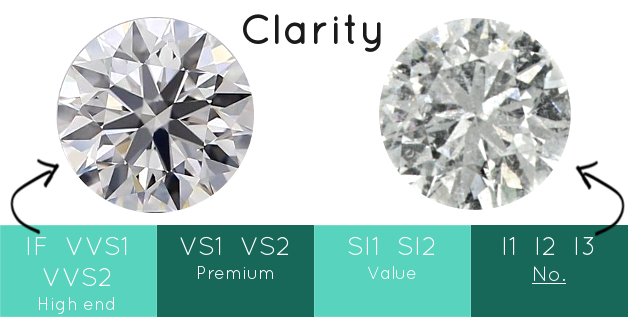
All diamonds have impurities. Some you can see with the naked eye, others not at all. The clarity is graded taking the following into consideration: where the impurities and imperfections are located, the number of them and their size. Every diamond is unique and has its own clarity fingerprint.
Diamond grading laboratories issue their grade on clarity at 10X magnification. You and I… we see at 1X.
So, if a diamond is free from imperfections and inclusions when viewed with the naked eye – that’s good enough, right? The best value can be found in VS1 and VS2 clarities.
This chart gives you a rule of thumb of whether an oval diamond will be eye-clean at a certain size.
Colour and size upgrades offer way more visual improvement than maxing out clarity. That’s where your budget should be working.
The chart above is in line with the benchmark grading of the Gemological Institute of America (GIA). They’re consistent and strict. We only sell diamonds graded by the GIA. For more information on the risk involved using other laboratories – head here.
Cut: The Most Important (And MISSING!) “C”
Diamond cut is often confused with the diamond shape (Round, oval, square).
It’s all about craftsmanship.
A diamond has very special light reflection and refraction characteristics. You can think of a diamond’s facets (sides) as internal mirrors that reflect light internally to and from the diamond’s environment.
Proper cut = optimal *sparkle*, life and fire.
Grading laboratories take some measurements of proportions, dimensions and symmetry and then issue a grade based on how close these parameters are to perfect. This grading is called the Cut, and graded as;
- Excellent: Perfect.
- Very Good: Go for it. Indistinguishable from Excellent cut to 99% of eyes.
- Good: Very broad grade. Some are fine some look terrible. Rather avoid.
- Fair: Avoid.
- Poor: No.
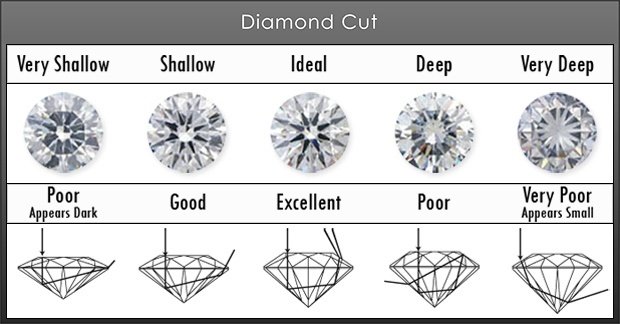
*Although this image displays round diamonds, the same goes for ovals.
You can have the highest known quality diamond – if it’s poorly cut it looks like nothing more than a dull piece of glass.
Imperfections in diamonds are also much more visible in poorly cut diamonds. When a diamond is properly cut the sparkle and life of the diamond easily masks minor imperfections. When it’s poorly cut – most specks and imperfections are easily visible. Not very beneficial.
There is never a reason to compromise on the integrity and quality of the cut. No colour, size or clarity can save a poorly cut diamond.
So why doesn’t an oval diamond have a “Cut” grading on the certificate?
Some grading laboratories do issue a cut grade for an oval, but if you’re looking at GIA options you’ll see the cut grade is missing in action on the certificate. This can be a bit of a downer.
There’s an interesting reason though.
If you consider a round diamond, the shape should obviously be perfectly circular.
What is the perfect length to width ratio of an oval cut diamond? This comes down to personal preferences according to most grading laboratories. Some people prefer a longer looking oval than others, and there’s no penalty for that. Here are three examples, with the centre one being the most popular;
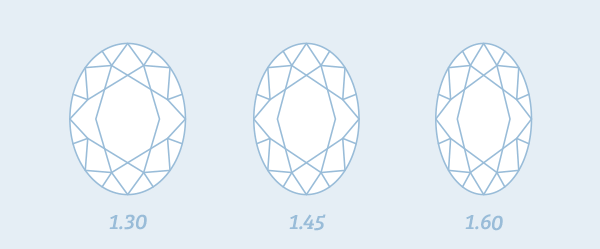
If you’re looking at an oval diamond option without an indicated cut grade, simply ensure that the polish and symmetry grade on the certificate is Very Good or Excellent. Then you’re set.
There is one thing to look out for while we’re on the topic…
Bow ties!
Just like all humans have faces… oval diamonds have a bow tie.
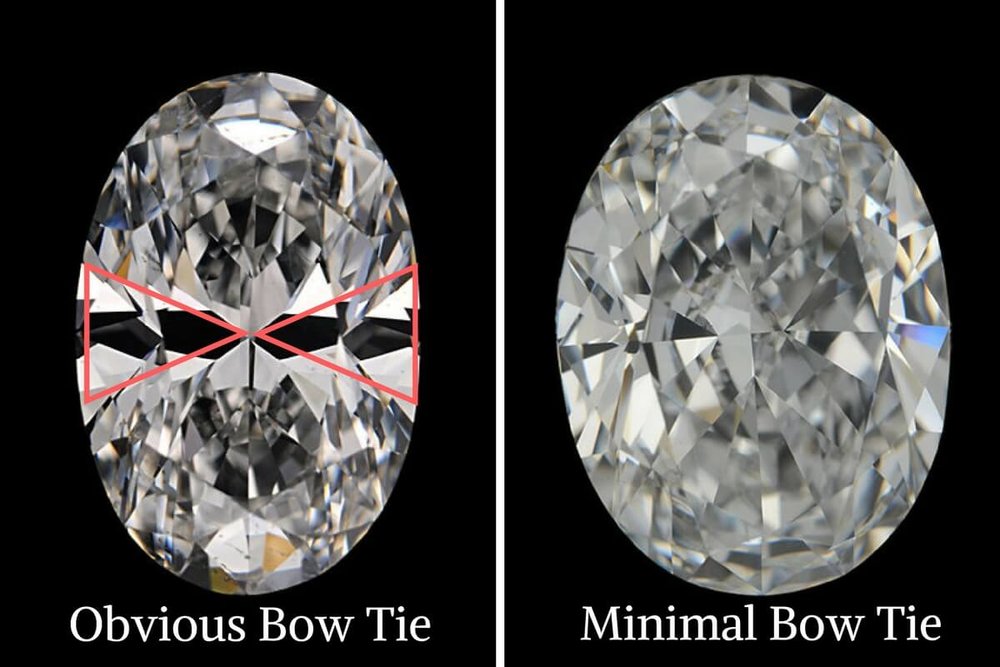
*These vary in severity, but can you see the obvious bow tie effect?
The concentrated facets at the edges of an oval shape creates more brilliance and sparkle than in the centre area. Think of it as changing gradients of sparkle throughout the oval.
For more homogenous brilliance; minimise the bow tie.
A cut grade can help you out here, but since you often don’t have one it helps if you know what to look for. The best way to get a feel for bow ties is to look at a few oval diamonds when selecting a diamond.
This is definitely an area that a reputable and knowledgeable diamond dealer or jeweller can help you out with.
Please don’t break your head on this, engineers. It’s part of the life of an oval diamond. See it as them dressing up fancily for you.
Some great design elements for an oval centre stone
East to West setting
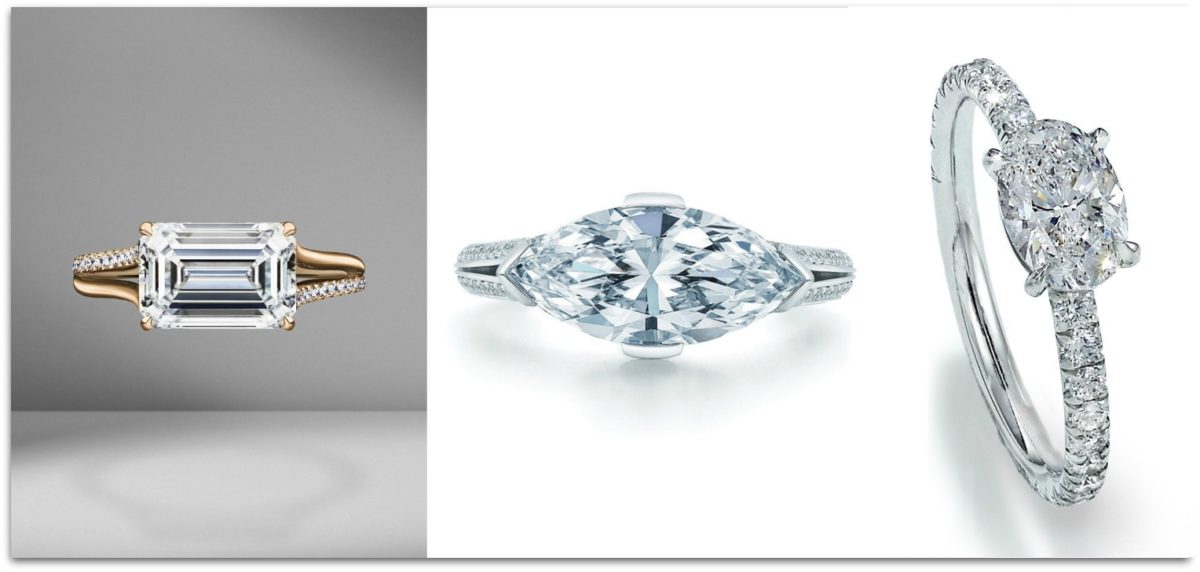
Well… just look at it!
Fascinating.
Something different? Absolutely, but not to the point where you’ll grow tired of it.
Diamond shapes like ovals, marquises and emeralds are usually set along the length of your ring finger. An east to west setting flips this and sets the main diamond across your finger. This creates a finer looking ring, while still flattering the oval shape.
And good news for those looking for side detail like vintage curls – this orientation gives you the largest blank canvas to work with.
90% of engagement ring designs can be tweaked to East-West. If you’re wondering about a design you have in mind, simply drop me an email here.
Solitaire
A solitaire setting contains only a single diamond – the centre stone.
The oval shape is unique, eye-catching and speaks for itself. Setting an oval solo style, ensures it stays the star of the show by working it’s magic without distractions.
Benefits include making the finger look more elongated and the diamond to metal ratio is low increasing the sparkle-factor.
By now you know oval diamonds appear to be the largest for any given weight, so they’re a wonderful fit for solitaires engagement ring designs.
Halo
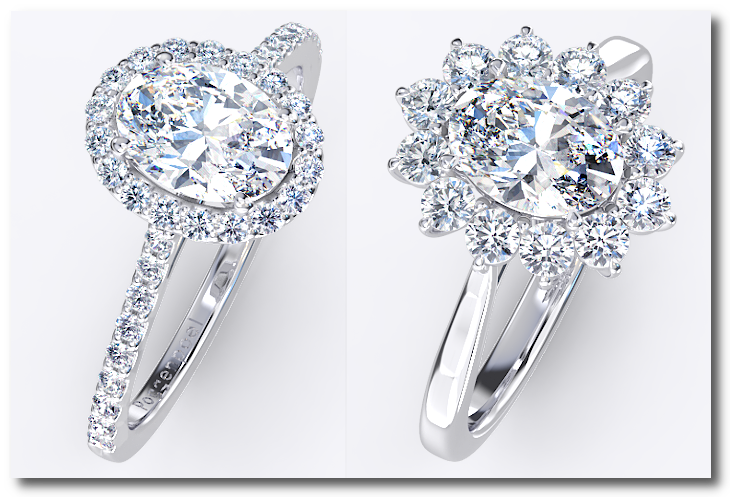 *Our Franci and Elva oval halo engagement rings.
*Our Franci and Elva oval halo engagement rings.
Halo’s work magic with oval diamonds.
A halo simply refers to a circle of small diamonds around the main diamond. Regardless of the shape of the centre diamond it increases the perceived size considerably.
A halo stunningly frames the oval shape, and since the small diamonds are usually round the contrast is stark and accentuates the main diamond.
Just a match made in heaven in my opinion.
3 Stone
*Our Jacquine and Jana three stone oval designs.
Three stone rings need a relatively large centre diamond to make the proportions striking.
An oval diamond draws the eye to it’s longest axis, so creating stunning and harmonious proportions is easier than with other diamond shapes.
To be frank, these rings also look expensive and luxurious (AF).
Find the perfect oval diamond
If this blog has been useful all I ask is that you please make us your first stop.
I promise you the following:
- I’ll take as much time is needed to ensure the ovals I offer you have the absolute best value.
- I’ll ensure the diamonds aren’t milky or have visible impurities.
- Bowties will be minimised.
- I’ll put in all the effort to get your ring’s design to your definition of perfect. Nothing less.
You can reach me at johan@poggenpoel.com, and I really look forward to meeting with you.
PS: you can see some diamond eye-candy at our studios in Rosebank and Pretoria. Please see the telephone numbers below.
Take care.
Johan Poggenpoel, Co-Founder.
T; 012 111 0525 (Pretoria) | 010 020 6811 (Johannesburg)
E; info@poggenpoel.com
Instagram:https://www.instagram.com/poggenpoeljewel/
Facebook; www.facebook.com/poggenpoel
Topics: Diamond Buying, Diamonds, Comparing Diamonds, Diamond Colours, Diamond Clarities

